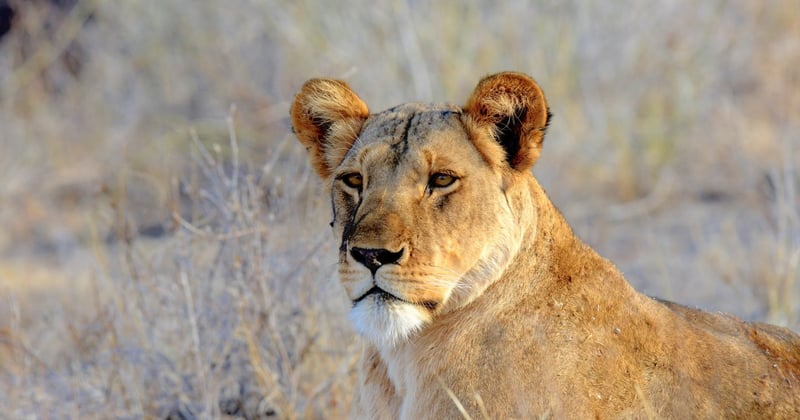
A life entertaining tourists is no life for a lion
News
Helen Proctor, our Sentience Manager, talks about the new trend to walk with lions and to pet lion cubs and the lifetime of suffering it causes them. Read her blog below:
Lions are incredible animals, majestic, regal and deadly - I can understand why unsuspecting tourists want to get up close and personal with them. It is tragic to see this interest in wildlife driving the demand for a cruel industry.
There are, of course, many ways to see lions in their natural environment. In the wild you can see their true behaviors and witness what really makes lions the awe-inspiring kings of the jungle.
Denying them a natural life
But lions that ‘walk’ with tourists have been denied their natural lives. They are normally hand-reared to develop the necessary strong bond with humans (Hunter et al., 2013). They are never given the chance to live as a real lion. They will never learn to hunt or be able to play for hours with the other cubs and adults in their pride.
They are also unable to spend their adolescence with their mother, learning from her, and being nurtured by her and this is a critical part of their development process.
The end result is abnormal adult lions without the necessary social and survival skills for life in the wild (Hunter et al., 2013). Consequently, lion park claims about their animals being the ‘real thing’, and ‘living as nature intended’, couldn’t be further from the truth.
To be hand-reared, lion cubs have to be separated from their mother at a very early age. Like all mammals, lions depend on their mothers as they grow up and they form an attachment very quickly (Gubernick, 2013; Newberry & Swanson, 2008). Separated cubs become incredibly distressed and fearful while the mother becomes distraught at the removal of her cubs (Newberry & Swanson, 2008).
Lions can't be tamed
Lions can never and nor should they, be tamed or domesticated. Their needs are just not compatible with our needs. And why should they share their lives with us when they have evolved for thousands of years to live in the environment they do?
One interesting study found that lions are entirely unsuitable to life in captivity (Clubb & Mason, 2003, 2007). In the wild, lions have one of the largest home ranges of all large carnivores, in which they travel in on a daily basis. This means that when they are caged, lions will pace more than other animals (Clubb & Mason, 2007).
When these lions aren’t ’entertaining’ tourists by walking or being petted by them they are kept in a cage for hours at a time. This happens especially during periods in the low tourist season, and at night when they should be most active. Cooped up lions become frustrated and bored, and they will often perform stereotypic behaviors such as pacing. This is not only heart-breaking to watch but is a clear sign that an animal is not coping with their environment (Bashaw & Kelling, 2007; Mason, 1991).
Sadly, the tourists visiting walking and petting attractions will be unaware of cruelty involved and the behind-the-scenes suffering. This is why we are telling the lions’ stories for them.
Take action
You can help. Lions and other wild animals are suffering at cruel tourist entertainment attractions. Join World Animal Protection to put wildlife protection on the agenda and reduce the tourist demand for cruel animal entertainment attractions.
References:
Bashaw, M., & Kelling, A. (2007). Environmental Effects on the Behavior of Zoo-housed Lions and Tigers, with a Case Study o the Effects of a Visual Barrier on Pacing. Journal of Applied Animal Welfare Science, 10(2), 95–109.
Clubb, R., & Mason, G. (2003). Animal welfare: captivity effects on wide-ranging carnivores. Nature, 425, 473–474.
Clubb, R., & Mason, G. (2007). Natural behavioural biology as a risk factor in carnivore welfare: How analysing species differences could help zoos improve enclosures. Applied Animal Behaviour Science, 102(3-4), 303–328.
Gubernick, D. (2013). Parental care in mammals. Springer Science & Business Media.
Hunter, L., White, P., Henschel, P., Frank, L., Burton, C., Loveridge, A., … Breitenmoser, U. (2013). Walking with lions: why there is no role for captive-origin lions Panthera leo in species restoration. Oryx, 47(1), 19–24.
Mason, G. (1991). Stereotypies: a critical review. Animal Behaviour, 41, 1015–1037.
Newberry, R., & Swanson, J. (2008). Implications of breaking mother–young social bonds. Applied Animal Behaviour Science, 110(1-2), 3–23.
Lions can never and nor should they, be tamed or domesticated. Their needs are just not compatible with our needs. And why should they share their lives with us when they have evolved for thousands of years to live in the environment they do?